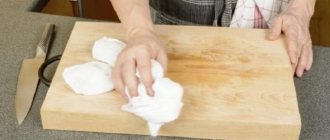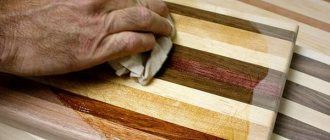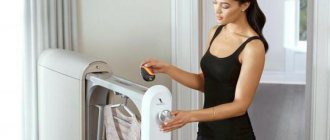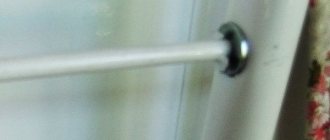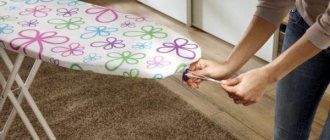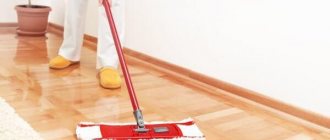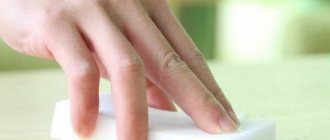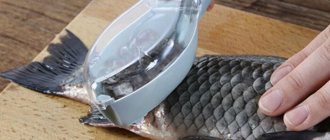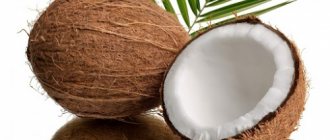A solid wood board for processing/cutting food products is an easy-to-use and environmentally friendly kitchen utensil. It is very popular due to its many advantages. True, a wooden board raises questions related to its cleaning.
The simple structure of wood facilitates the rapid absorption of liquids. The main problem is not even the “aroma” that permeates the product after processing meat/fish products. Small particles of food that remain on the surface contribute to the proliferation of dangerous microorganisms. This, in turn, is a health threat. There are many cases of food poisoning associated with insufficiently clean cutting boards.
Laundry soap
To avoid the appearance of mold or pathogenic microorganisms on the cutting board, it is necessary to apply foam from laundry soap to its surface immediately after use.
It is especially important to do this after cutting meat or fish. By doing this, you will not only extend the life of your board, but also avoid many health problems.
Wood condition
If the board starts to look dull or feels a little rough, the wood needs to be conditioned. Do not use olive oil or other vegetable oils because they may go rancid. Use food grade, highly refined mineral oil.
Apply a generous layer of mineral oil to the board and spread evenly with a paper towel. Leave for at least two hours or overnight. Repeat for the other side of the board. Wipe off excess oil with a paper towel and place the board sideways or upright on a rack to dry completely.
The oil will fill all the nooks and crannies in the wood grain and prevent water and bacteria from getting into the board.
Chlorhexedine or hydrogen peroxide
Pharmacy products can also be good helpers in the fight against dirty surfaces. This is especially true if the board is often used for working with raw meat products.
- Buy a three percent solution of hydrogen peroxide or Chlorhexidine at the pharmacy and pour it onto the board.
- Using a clean kitchen sponge, spread the solution evenly over the entire surface, including the sides.
- After 10 minutes, rinse the solution with water and dry with a paper towel.
Never wipe the board with a regular kitchen towel, as it may also contain bacteria, which will again end up on the newly cleaned board.
What you will need
- Dish sponge;
- sink or large basin;
- dryer sheets;
- drying rack;
- warm water;
- dishwashing liquid;
- distilled white vinegar or hydrogen peroxide;
- 2 teaspoons chlorine bleach;
- baking soda;
- 1 lemon, cut in half;
- edible mineral oil;
- paper towels.
Sandpaper
Sometimes dirt eats into the fibers so much that it is not possible to wash them using conventional means. Then sandpaper will come to the rescue.
To do this, you need to take fine-grained sandpaper and carefully sand the entire surface.
As you can see, any of these methods will help tidy up your kitchen appliances, and most importantly, without the use of harmful chemicals.
Specifics of using cutting boards
Every housewife has several types of wooden and plastic boards of different quality and size in her arsenal. Each is intended for a specific type of product, which is provided for by sanitary standards.
When cutting, shredding and beating, kitchen utensils are subjected to the aggressive effects of a knife or hammer, leaving barely noticeable cuts or chips. Products fall into the formed grooves.
If they are not removed in a timely manner, they deteriorate, decompose, acquire an unpleasant odor, and subsequently can get into food and cause poisoning. Therefore, simply wiping with a sponge, shaking off crumbs or rinsing under running tap water is not enough to ensure the sterile cleanliness of utensils necessary for daily use.
Differences between plastic material and wood
Depending on the surface material, the methods for cleaning it vary. Suitable for wooden:
- salt and lemon;
- vinegar;
- baking soda;
- petrolatum;
- toothpaste;
- potato or apple pulp;
- laundry soap;
- steel sponge.
For plastic boards you can use:
- vinegar;
- soda;
- potato;
- White Spirit;
- microwave;
- bleach;
- laundry soap.
Now you know how to ensure long service life of your boards. This will not only save your budget, but also make cooking more enjoyable. Good luck!
Key points:
- Different types of food require different cutting boards. This way you can avoid food poisoning when preparing meat products and you won’t have to constantly wash the same board when cooking.
- Hot water and dish soap are essential for daily cleaning of cutting boards.
- Once a week, thoroughly disinfect all cutting boards.
Adviсe:
- Some food odors, such as garlic, onions and fish, are difficult to avoid. Dip a paper towel into pure lemon juice or take a lemon wedge and rub the surface - your cutting boards will smell citrusy fresh!
- Rub the board with coarse salt or baking soda to remove strong odors. Leave the substance on the board for 2 - 3 minutes, then wipe the treated surface. Rinse cutting board and dry.
- Bacteria die without moisture. Store the board in a dry place away from food and any other contaminants. Store your board upright when not in use.
How to remove odor
Despite its ease of use, wood has one rather significant drawback - it actively absorbs foreign odors. And if at first this is not always noticeable, then over time it can cause discomfort when cooking. The most important rule is regular processing.
There are several remedies that can help cope with the problem:
- Vinegar. It is used to wipe the surface immediately after cutting food. This method works well with the aromas of fish, raw meat, garlic and onions. An alternative to vinegar is a slice of lemon.
- Coffee, tea leaves, mustard powder or charcoal. Anyone can rub the wood, and the unpleasant amber will disappear.
- Saline solution. You can resort to this method if you are not afraid of deformation of the wood. In this case, four tablespoons of salt must be dissolved in a liter of hot water.
Cleaning powders are not the best option
Some housewives use various cleaning powders to clean wooden cutting boards. It's best to refrain from doing this. Despite the fact that they effectively remove various odors and dirt from almost any surface, it is highly not recommended to use such substances for cleaning kitchen utensils, especially wooden cutting boards - powder particles may remain on their surface and, upon further use, end up in the food you prepare. It probably goes without saying that this poses a threat to the health of all members of your family.
Features of plastic and wood
For several decades now, plastic and wood have been at the top of popularity in the manufacture of cutting boards. But, as they say, every coin has two sides. So, the listed materials have both positive and negative sides. Let's dwell a little on these points.
Tree
This material has its advantages:
- ease of use;
- relatively low cost;
- environmental friendliness;
- strength.
Flaws:
- the material absorbs fruit and vegetable juice;
- rapid contamination and wear.
Plastic
The following positive aspects of this material can be highlighted:
- color variety;
- does not absorb odors;
- strength;
- ease.
Minuses:
- no antibacterial coating;
- slippery surface;
- questionable environmental friendliness.
Wood cutting board, how to polish it
After years of use, wood cutting boards require refinishing to remove any rough edges.
To polish a wooden cutting board, experts first use a regular pencil to draw X's on both sides of the cutting board. Then use a sheet of 200-grit sandpaper to lightly sand the wood until all pencil marks are gone and the surface is smooth. Next, use a sheet of ultra-fine 500-grit sandpaper to go over the wood for a finishing touch.
Once your wood cutting board has been sanded, it is best to treat it as described above to protect and prepare it for future use.
Methods for cleaning boards
It is not for nothing that sanitary standards stipulate the presence of different kitchen boards for each type of product. But with frequent use, not only marks from the knife blade are formed on the surface, but also barely noticeable food particles accumulate, which subsequently deteriorate and, if not properly cared for, enter the body.
There are several ways to clean cutting boards using available products found in any kitchen. For clarity, we illustrated our tips with photos, thanks to which you should not have any questions related to caring for your utensils.
Salt and lemon
A good method that allows you to process wooden boards in particular. As a result, you will not only clean the surface, but also give it a pleasant light citrus aroma.
When using salt, use coarse rock salt. This product will have a greater scrubbing effect.
- Scatter a generous handful of salt over the board, spreading it evenly around the entire perimeter.
- Cut the lemon into two parts across the fruit and grind the salt. Pay special attention to the most problematic areas.
- When the mixture turns into a grayish paste and then completely dissolves in lemon juice, rinse with water.
Tip: don't forget about the end side. Despite the fact that you do not cut up food on it, the microbial environment does not stop progressing.
Lemon juice
You can treat the surface using the same principle with salt, only using its juice rather than lemon. This is sold in stores in small containers.
In this case, a rather thick mass is prepared from rock salt with citrus liquid, which is then rubbed onto the board. For greater effect, use a metal sponge. This is especially true for old pollution.
Tip: if you can’t quickly deal with the problem, apply the paste to difficult areas and leave for a while.
Vinegar
Using an acidic environment is a great way to not only wash household items, but also get rid of various types of microbes. For cleaning, it is recommended to use table vinegar, but not essence. In the latter case, you risk damaging your hands. A concentration of 9% is quite sufficient.
You can use the product either in its pure form or by preparing a weaker solution in a 1:1 ratio with liquid. This is done like this:
- Fill the bottle with vinegar and cap it with a screw-on spray nozzle.
- Treat the surface after each cutting of food. Rinse the board under the tap at the end of the procedure.
Tip: for greater effect, additionally go over the surface with a sponge with hydrogen peroxide.
Bleach
It is not advisable to treat wooden cutting boards with chemicals. The porous surface of wood, compared to plastic, absorbs substances contained in bleach that are harmful to the body quite well. If the material is not natural, follow this algorithm:
- Pour warm tap water into a basin of suitable size and add about 100 ml of bleach (can be replaced with white).
- Place a board into the solution. Leave for no more than half an hour to soak.
- When the stains come off, it is necessary to remove chemical residues from the surface. To do this, wash the board with a saturated soap solution.
Soda
Using baking soda for cleaning is far from original, but it is an effective method. This powder has proven itself in the fight against pollution. Among other things, a paste made from it helps to cope with unpleasant odors:
- In a bowl, combine baking soda with a small amount of liquid. Stir. It is necessary to achieve a fairly thick consistency.
- Apply the resulting composition to the surface, spreading it evenly. Leave for a few minutes. Rinse thoroughly afterwards.
Petrolatum
Wooden objects, unlike plastic cutting boards, have a peculiarity - with prolonged use, unpresentable stains begin to appear on the surface.
This aspect does not particularly affect the cooking process itself, but it is not worth dealing with it by soaking - the board may swell, after which it will be impossible to return to its previous appearance. To eliminate this kind of contamination, do the following:
- Coat the tree with a thin layer of pharmaceutical Vaseline and leave it in this condition for at least 12 hours.
- After the specified time, the color should even out. At the end of the manipulations, do not forget to remove any remaining substance with a damp cloth.
Toothpaste
This method helps to get rid of roughness on kitchen utensils by hand polishing using a special composition:
- Combine dentifrice and baking soda in a container. Mix thoroughly until the grains disappear.
- Wipe the board area with the resulting mixture. Make movements not against, but along the characteristic pattern.
- Use a damp cloth first and then a dry cloth.
Important: gel is not suitable for the procedure. Preference should be given to regular white toothpaste.
Grated apples or potatoes
Another option for dealing with unpleasant odor is an apple or potato. They can be used to both clean a plastic cutting board and tidy up wood products. Follow our advice:
- Finely grate any of the following products.
- Apply the puree to problem areas. Leave it for a while.
- Rinse with water after a quarter of an hour.
Microwave
The principle is based on the sterilization of cans, however, only small boards are suitable for it. As a result of the following actions, the item is completely disinfected:
- Wipe the work surface with a damp cloth and place it in the microwave oven compartment.
- Set the timer to no more than a minute. Remove with care - the item will heat up during processing.
Important: do not disinfect thin boards in the microwave.
Laundry soap
When cutting meat on a wooden surface, many have encountered the problem of quickly absorbing blood. This not only spoils the appearance of the item, but is also extremely unhygienic.
In this case, always keep laundry soap on hand. It is necessary to make a thick foam from it, which is applied immediately after cutting the product and only then rinsed in water.
Steel sponge
A rather radical method is the use of a hard washcloth, which is often not recommended. The fact is that along with the dirt, it also removes the thin top layer of wood.
White Spirit
If none of the above methods succeed in getting rid of old stains, dip an iron sponge in the solvent.
The main thing in this case is to thoroughly rinse the surface of the board to remove any corrosive odor and chemicals and dry it in the fresh air.
Vegetable oil
You can restore the surface to its former smoothness by rubbing it with a solution of oil and vinegar - these components are mixed in a 3:1 ratio.
How to clear the board?
Cleaning wooden kitchen boards is not a difficult process, but it does require some effort.
You need to do the following:
Delicious lean dessert made from semolina and coconut flakes: no need to even bake
Why spend a lot of money on mouthwash? Homemade recipe without chemicals
Why natural sounds not only lift your mood, but also relieve stress
- scrape off food residues from the wooden surface or brush them off;
- rinse the board in running water;
- dilute detergent in warm water and whip up foam;
- wipe the entire surface of the board with the solution;
- Rinse off the cleaning solution with water.
After washing the board, you need to put it on the dryer and start preparing another solution.
How to remove mold from boards?
To get rid of mold at home without much effort, just use regular whitewash. You should moisten the sponge with white, and then carefully wipe the wooden surfaces. Mold removal will begin in approximately 10 minutes.
Interesting materials:
How to soften clay if it is like stone? How to soften mastic if it has dried? How to plant gooseberries and when? How to reset an iPad to factory settings if you forgot the password? How to reset settings on iPad if you forgot your password? How is salary calculated if there was sick leave? How to make such a request in a search engine so that it shows results containing the exact set? How to save aloe if the roots are dry? How to save Slime if it is liquid? How to minimize a game on a computer if it does not minimize?
Preventing food contamination
Who wants to suffer from food poisoning? Follow these simple tips to avoid such problems:
- Buy hard acrylic or rubber boards as they are the most hygienic to use (these are the boards commonly used in restaurants).
- Wooden boards should be disinfected regularly and kept as clean as possible.
- It is convenient to have several boards for different types of food. You should have at least two of them: one for raw meat and fish, the other for vegetables, bread and any other foods that can be eaten raw.
- Buy colored sets of cutting boards or label the boards yourself, this will make it much easier to distinguish them by purpose.
- Throw away any cutting boards that have cracks, large scratches, or obvious signs of dirt. Like all kitchen utensils, cutting boards have an expiration date and it is important to dispose of them promptly to maintain kitchen hygiene and cleanliness.
Processing cutting boards
Most wooden cutting boards are made from hardwoods such as teak, although bamboo cutting boards are also quite common. Any type of wood should be treated to prevent stains and keep food odors and bacteria from lingering on the surface.
Use an oil that can be used repeatedly, such as food-grade mineral oil. It is safe and will fill the pores of the wood well. Another name is liquid paraffin, edible petroleum jelly. Rub the oil onto the board and let it soak into the wood. Wipe off excess oil with a clean, dry cloth. Repeat this process at least once a month.
Attention! Do not use vegetable oil on cutting boards. This oil will go rancid and cause an unpleasant odor.
The bourgeois internet recommends using coconut oil for these purposes:
After mineral oil, apply beeswax , it will make the surface of the board waterproof, which will protect the wood from wear and tear and extend its service life. In a microwave-safe container, microwave 1/2 teaspoon (2.5 ml) beeswax with 1 cup (240 ml) mineral oil for about 45 seconds. Apply warm wax to cutting board. Based on materials from www.cleanipedia.com, ru.wikihow.com
Wooden kitchen cutting boards have many advantages compared to their plastic and ceramic counterparts. Products do not slip on their surface, allowing you to cut them much more confidently and quickly. In addition, dense wood, in addition to its environmental friendliness, is also famous for its durability, so wooden boards last much longer than their other analogues.
But wooden cutting boards have their drawbacks. The main ones are the ability of wood to absorb odors and change its appearance for the worse. In order for the board to last longer, it is necessary to properly care for it. I hope now you know how to do it :o)….
See also:
A product that will remove scratches from any wooden furniture
We care for the frying pans
How to Clean a Cutting Board with Lemon and Table Salt
These products can be used to clean a wooden board very well. First, rub fine salt into the surface, and then rub with cut lemon. The fruit must be squeezed so that juice drips from it.
Gradually the liquid will become grayish in color, and the salt will completely dissolve. Leave the board for 15 minutes and then rinse off the mixture with running water. All that remains is to wipe the board dry.
Features of plastic and wooden boards
Photo: https://pixabay.com/photos/cutting-board-background-culinary-2680186/
There are different ways to remove dirt from the surface of kitchen utensils. When using them, you need to take into account the material from which the product is made.
- Plastic boards. They are smooth. They look perfect on the outside, but the cuts left by the knife often harbor bacteria that need to be gotten rid of. Plastic products are easier to clean and can be placed in the dishwasher or washed in hot water using special products.
- Wooden boards. They are more porous. But much safer to use than plastic ones. Wood absorbs bacteria. Getting into its deep pores, they die. But wooden objects are afraid of moisture. They cannot be washed in the dishwasher. They take a long time to dry, which increases the risk of bacterial growth. Their advantage is their long service life.
Experts advise using plastic products for cutting vegetables and fruits. For raw products, especially meat, wood boards are more suitable.
It must be remembered that any kitchen utensil requires proper maintenance and timely cleaning. To protect yourself and your family from food poisoning, you need to use all available cleaning methods.
Storing kitchen boards
It is better to purchase a special stand for boards, and not hide them in cabinets with blind doors. They should be kept outdoors in a well-ventilated area. It is better to place them away from the stove, and also to exclude exposure to sunlight. In addition, you should not place them near the sink so that the product does not absorb excess moisture.
